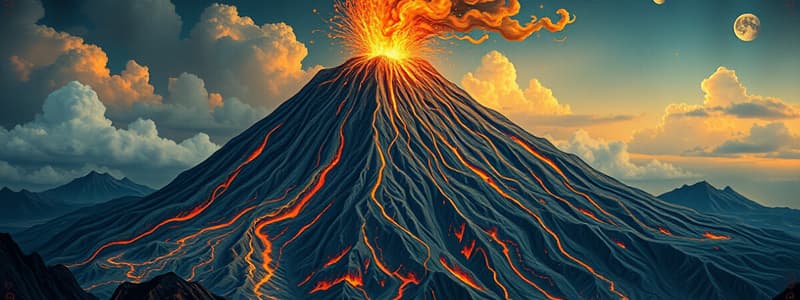Podcast
Questions and Answers
What is a volcano?
What is a volcano?
Opening or vent in a planet's crust from which molten rock, ash, and gases escape.
What type of volcano is Mount Rinjani?
What type of volcano is Mount Rinjani?
Active volcano
What defines an active volcano?
What defines an active volcano?
Has erupted within the last 10,000 years; has erupted in recorded history.
What is an extinct volcano?
What is an extinct volcano?
What is another name for a dormant volcano?
What is another name for a dormant volcano?
What type of volcano is characterized by having a tall mountain with a crater on top?
What type of volcano is characterized by having a tall mountain with a crater on top?
What does silica do to lava?
What does silica do to lava?
Where is Mount Krakatoa located?
Where is Mount Krakatoa located?
What is a shield volcano?
What is a shield volcano?
Which shield volcano is located in Hawaii?
Which shield volcano is located in Hawaii?
What are cinder cones made up of?
What are cinder cones made up of?
What are pyroclasts?
What are pyroclasts?
Where is Paricutin located?
Where is Paricutin located?
What makes submarine volcanoes easier to detect?
What makes submarine volcanoes easier to detect?
What are hydrophones used for?
What are hydrophones used for?
Where are subglacial volcanoes typically found?
Where are subglacial volcanoes typically found?
What does IAVCEI stand for?
What does IAVCEI stand for?
What factors define Decade Volcanoes?
What factors define Decade Volcanoes?
Flashcards are hidden until you start studying
Study Notes
Volcano Definition and Types
- A volcano is an opening in a planet's crust where molten rock, ash, and gases are expelled from below.
- Mount Rinjani on Lombok is Indonesia’s second highest active volcano.
- Active Volcanoes erupt within the last 10,000 years and have documented eruptions.
- Extinct Volcanoes have no eruptions in historical times and are unlikely to erupt again due to depleted magma supply.
- Dormant Volcanoes are also known as inactive volcanoes.
Volcano Classifications
- Composite Volcanoes (Stratovolcanoes) are characterized by tall peaks with craters, releasing pyroclastic materials, gases, and lava. They are the most common type.
- Silica in lava increases its viscosity, allowing it to reach significant heights.
- Shield Volcanoes have broad, gentle slopes resembling a warrior’s shield, with lower silica percentages making the lava less viscous. Example: Mauna Loa in Hawaii.
- Cinder Cones (Pyroclastic Cones) are typically small and composed of pyroclasts, often forming groups around larger volcanoes, with most eruptions occurring only once.
- Submarine Volcanoes are easier to detect in shallow waters.
Volcano Characteristics and Detection
- Pyroclasts are fragments of volcanic rock that create steep slopes surrounding wide craters.
- Paricutin is a notable cinder cone located in Mexico.
- Hydrophones are devices invented in Britain for detecting underwater volcanic sounds.
- Subglacial Volcanoes are found in high-latitude regions, such as Iceland.
Organizations and Hazard Assessment
- The International Association of Volcanology and Chemistry of the Earth's Interior (IAVCEI) is an organization focused on volcanic research.
- Decade Volcanoes are distinguished by their history of destructive eruptions and proximity to populated areas.
Studying That Suits You
Use AI to generate personalized quizzes and flashcards to suit your learning preferences.




